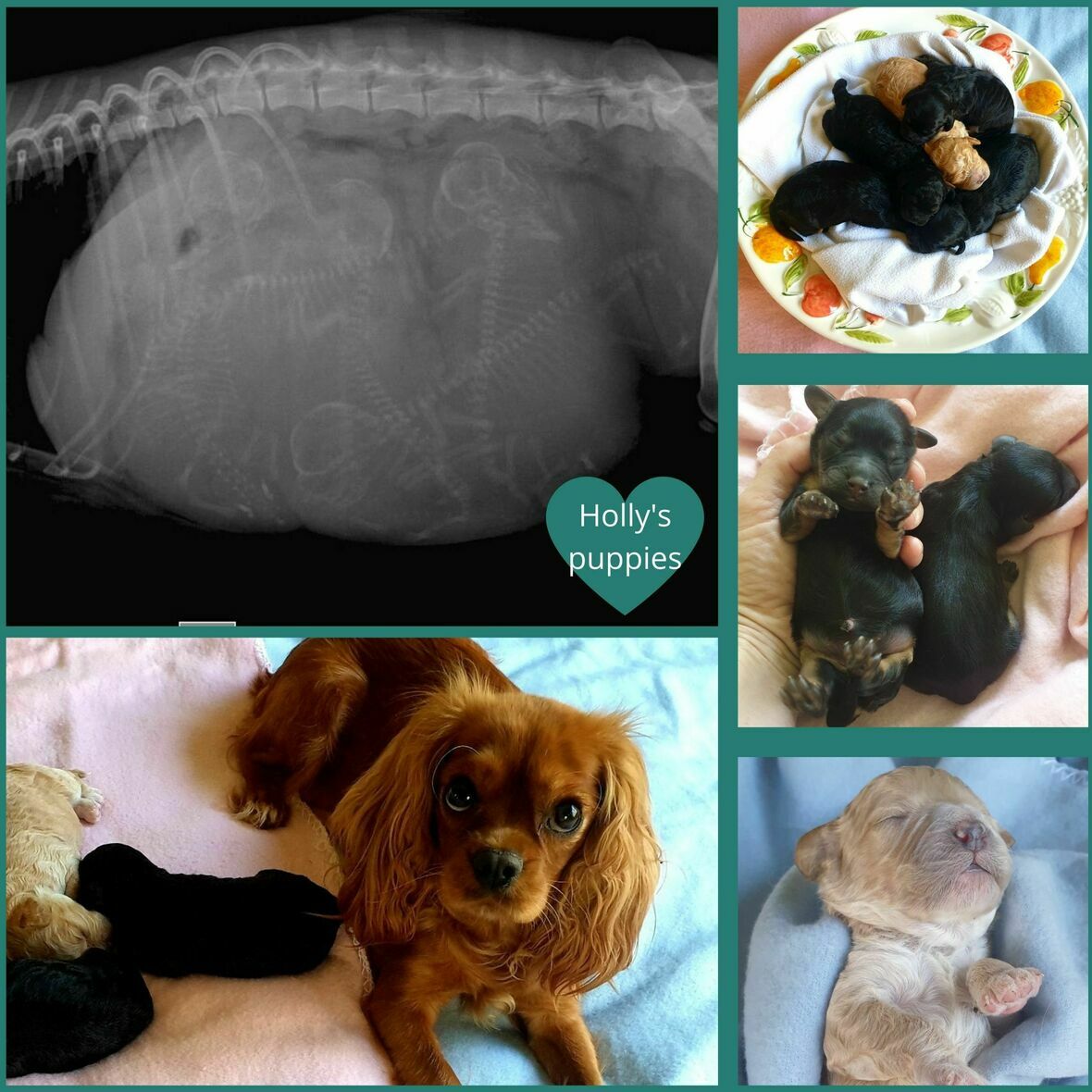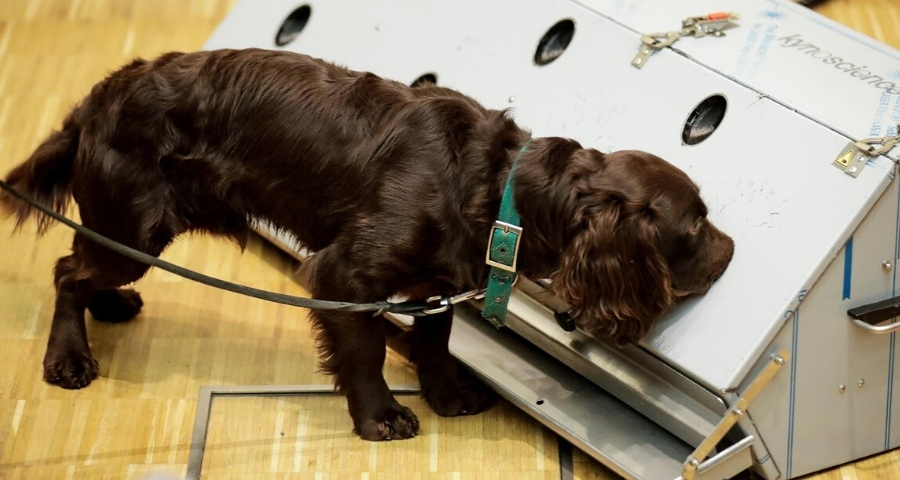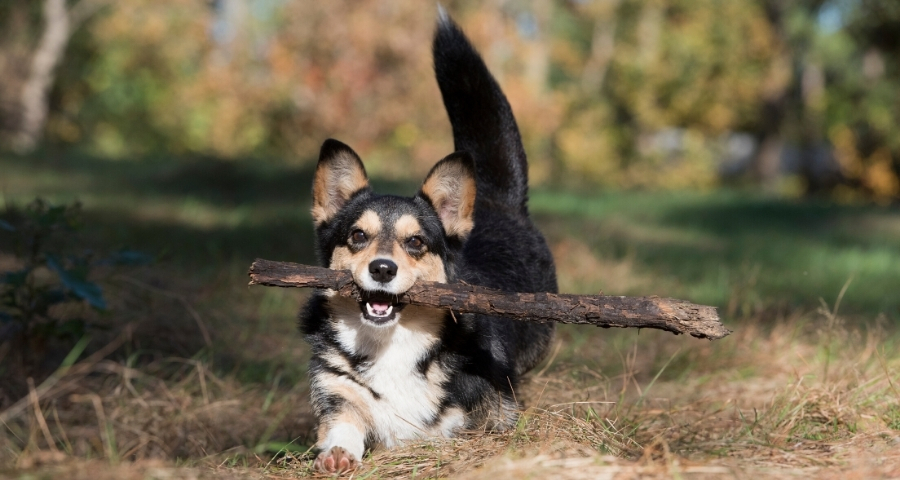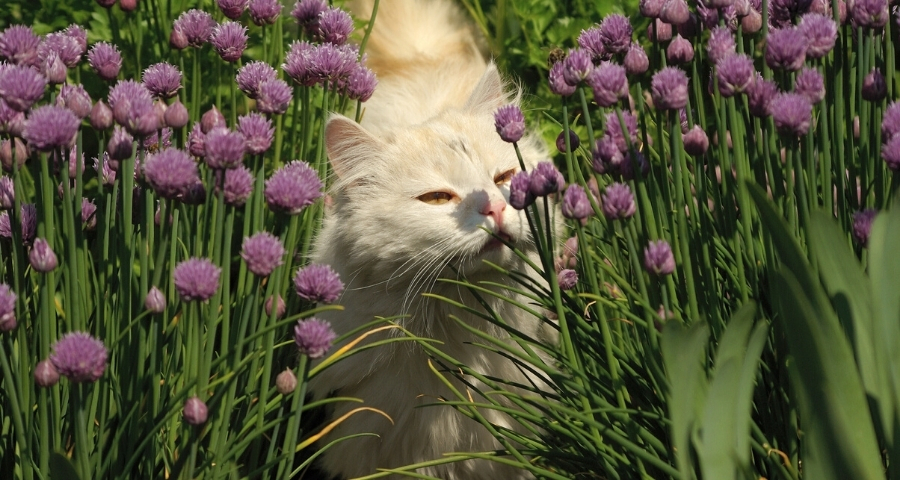| |
|
|
| |
Mira Mar Veterinary Hospital
|
|
| |
|
|
| |
|
|
| |
|
|
|
|

|
| |
APRIL NEWSLETTER
|
|
| |
|
|
| |
Hello! Welcome to our April newsletter edition.
This month we have some great information on some of our most popular pet breeds, and how to ensure that they stay as healthy as they can!
Also there is a lovely good news story from a little dog Holly, who successfully delivered a litter of puppies last month, with a little help from Dr Jim and a car journey!
Please note our opening hours for Easter:
- FRIDAY 2nd APRIL: CLOSED
- SATURDAY 3rd APRIL: 9AM - 12PM
- SUNDAY 4th APRIL: CLOSED
- MONDAY 5th APRIL: CLOSED
We wish all of our wonderful clients and their pets a safe and happy Easter break!
|
|
|
|

|
| |
Holly's puppies
|
|
| |
|
|
| |
Holly is a very sweet King Charles Cavalier Spaniel, who was pregnant with her first litter of puppies. She visited the clinic for an x-ray prior to the birth, which showed that she had 5 little skeletons inside her tummy!
A week later, as predicted, Holly started going into labour at home and delivered her first puppy. That's when things started to go wrong, as Holly stopped contracting and her owners became worried. They called Dr Jim in the early hours of the morning and all agreed that Holly needed to be examined. The good news is that Holly delivered the next puppy herself in the car on the way to the clinic! Dr Jim met them on the side of the road to check Holly over and give her the go ahead to proceed with the birth. She then went on to have another three healthy puppies back at home, who are all thriving and well.
Congratulations to Holly and her gorgeous litter of puppies! |
|
|
|

|
| |
Keeping up with high-energy dog breeds
|
|
| |
|
|
| |
High-energy dog breeds make for fun exercise and play buddies - and can also be great “workers” if their energy is channelled into a productive task.
Within any breed, there is some variability in temperament. However, high-energy dogs tend to be:
- Border collies
- Kelpies
- Cattle dogs
- Siberian huskies
- Jack Russell terriers
- Aussie shepherds
- English springer spaniels
- German shepherds
- Beagles
These breeds were bred for a specific “job” and want to be busy, so if their exercise and mental stimulation requirements aren’t met, they can develop undesirable behaviours, such as hyperactivity, escape tendencies, anxiety or destructiveness.
Ensure you meet the physical energy demands of your dog each day with activities suited to their capabilities. This can include long-lead walks or runs, off-lead running in a confined area, play with other dogs or ball games. An automatic “ball-launcher” toy in the backyard can also provide great entertainment for those really ball-obsessed dogs!
Mental stimulation is just as important for your pet, so ensure you provide a regular rotation of stimulating food, chew and puzzle toys for them to work out.
If you are going to be away for long periods each day, consider trialling your pet at a reputable local doggy daycare facility, where they can have supervised free play-time with other similar dogs.
Lastly, giving your high-energy dog a “job” to do can be a really effective way of providing both mental and physical stimulation. Many busy dogs excel at advanced obedience or agility training, or activities such as flyball.
As a counter to all these stimulating activities, many high-energy dogs also benefit from a program of “conditioned relaxation”, where they are taught to relax on cue. A good dog behaviour trainer will be able to assist you with this.
If you’re choosing a new high-energy pet or need advice on training, speak with our friendly team today! |
|
|
|

|
| |
Not just a squishy face - brachycephalic pet issues
|
|
| |
|
|
| |
Brachycephalic dog and cat breeds are those with shorter faces, such as English bulldogs, French bulldogs, Pugs, Pekingese and Boston terriers, as well as Persian and Himalayan cats. While these breeds can make great companions, unfortunately, years of selective breeding for those large expressive eyes and snubby noses means brachycephalics are predisposed to a number of health conditions.
You may have heard about brachycephalic obstructive airway syndrome (BOAS) - a combination of airway problems that brachycephalic dogs and cats commonly suffer from. These include narrow nostrils, an overlong soft palate and protruding tissue folds in the throat. BOAS causes varying degrees of difficulty in these animals, ranging from noisy, effortful breathing to sleep apnoea or episodes of fainting. These pets are also at higher risk of heat stress.
Unfortunately, brachycephalic breeds can be associated with other health issues too, such as:
- Shallower eye sockets and wider eyelid openings leading to dry, irritated eyes (which can develop painful ulcers), and “runny eyes” resulting in tear-staining and facial skin irritation
- Crowding and abnormal positioning of teeth leading to dental problems
- Excessive skin folds on the face (and sometimes around the tail), leading to skin irritation and infection
- Intermittent vomiting/regurgitation due to a suction effect from increased breathing effort and abnormal stomach position
- Brain/spinal issues due to abnormal skull shape
- Increased risk of birthing difficulties, leading to a higher necessity for caesarean section
If you have a brachycephalic cat or dog, we recommend having a consultation with one of our vets on how to best care for your pet. There are supportive treatment and management options available, which can help your pet with any brachycephalic-related issues they may be having, so they can live their happiest, healthiest and longest life with you. |
|
|
|

|
| |
Looking after poodle cross-breeds
|
|
| |
|
|
| |
Do you own an “-oodle?” Poodle crosses (such as the cavoodles and labradoodles) are very popular pets due to their friendly nature, intelligence and appealing looks. These dogs are also frequently favoured for their coat type, which in most cases is low shedding – this means less hair on your clothes and furniture!
Are poodle crosses hypoallergenic?
Whilst poodle crosses are often marketed for their “hypoallergenic” fur, this is not always the case, as there can be great variation in coat types even amongst one litter. If you really wish to lower the chances that your dog will trigger pet hair-related allergies, it’s best to choose a pup where both parents have low-shedding coats e.g. both parents are poodles or bichons, or a cross of these two breeds.
What special care will my “-oodle” require?
Poodle crosses have constantly-growing fur, which requires regular grooming every six-to-eight weeks. In between grooming appointments, your pet will generally need:
- Regular brushing to prevent matts, particularly behind their ears, and around their belly, armpits and groin
- Careful trimming of fur from around their eyes, so that long hairs don’t rub and cause irritation (ask our team for advice on how to do this if you’re unsure)
- Regular checks of their ears and skin - some poodle crosses can suffer from allergies, causing itchy ears, skin or paws (if you notice any ear redness or smell, hair loss, itching or redness of your pet’s skin or paws, book them in for a consultation with us today)
Poodle cross dogs can also suffer from any of the common genetic diseases of poodles or other breeds in their lineage, so we’d recommend thorough research before purchasing.
Have a chat with our team if you have any questions or concerns about your pet. |
|
|
|

|
| |
Animal News In Brief
|
|
| |
|
|
| |
Image source: Reuters
Sniffer dog smelling human saliva samples.
It’s time to take notice of canine ehrlichiosis
Last year saw canine ehrlichiosis introduced to Australia for the first time in history. Previously, the disease had been identified in every continent around the globe - except Australia - until it mysteriously hit Western Australia’s Kimberley region last May. The disease since spread across in the Northern Territory. Caused by the bite of the bacterium-carrying “brown dog tick”, the disease, though not contagious, is often fatal, as major signs are not obvious until it’s already too late. The tick has also been recently spotted in South Australia, opening concerns that it could travel to more populated areas. The good news is that if veterinary attention is sought when the dog is still in the acute phase of the infection (one-to-three weeks after being bitten), it is possible that they will survive. Signs to look out for during the acute phase are listlessness, loss of appetite, enlarged lymph nodes and fever. Prevention is possible too! Products with tick repellent action, such as tick collars containing flumethrin (an acaricide) and imidacloprid (an insecticide) are the most proactive way you can ensure your pooch stays protected.
Read more about ehrlichiosis from ABC News here and VIN News here.
-----
German vets training COVID-19 sniffer dogs
Using human saliva samples, dogs from Hanover’s University of Veterinary Medicine in Germany are learning to use their clever little snouts to sniff out the cells of people infected with COVID-19. Given the pooches are able to pinpoint the odour at a 94% accuracy, Hanover’s premier has expressed interest in giving the pups the very special task of putting their noses to the test at concerts and other public events around Hanover. Across the globe, pup nose power is already being used to target the virus, with Chile and Finland employing sniffer dogs at their international airports. Stories of such sensory intelligence reminds us to appreciate just how incredible our furry friends really are. Having the potential to assist communities around the world in defeating the virus, the sniffer dog initiative might just be following a scent in the right direction.
Read more about Germany’s sniffer dogs here.
-----
Pet care hack: Pet owners urged to take heed of Woolies’s novelty seeds
Despite the educational benefits and free additions to the veggie patch, several of the ‘Discovery Garden’ collectable seedlings offered out by Woolworths have been identified as toxic to pets. Although the supermarket giant acknowledges that pets shouldn’t ingest the seeds, keeping them out of reach of our furry friends is another task altogether. Due to the sneaky nature of our pets, it’s best to not take any chances of toxin ingestion and keep to pet-friendly plants instead. So the next time you receive a collectable seed, check first that it’s safe, in case your pet sneaks a feed.
Plant peril goes beyond the Discovery Garden! With shops like Bunnings offering plants in abundance, it can be easy to select something without knowing whether it’s pet-friendly. The toxicity risk is generally low unless your pet really likes to get in amongst your garden or sample what's there, but just so you are aware - here are some of the potentially toxic plants to consider avoiding: |
|
|
|
| |
- Dianthus
- Poppy
- Lavender
- Swan River Daisy
|
|
|
| |
- Bunching Onion
- Cherry Tomato
- Oregano
- Chives
|
|
|
|
|
| |
Ask our friendly team if you are unsure about which plants you should keep your pet from.
Read more about the toxins of the Woolworths Discovery Garden here. |
|
|
|

|
| |
Short-legged dog breeds 101
|
|
| |
|
|
| |
Short-legged dog breeds, such as dachshunds, corgis and basset hounds make for popular pets due to their distinct appearance. There are whole internet photo collections dedicated to hilariously chunky corgi rumps - just Google “corgi butts” if your interest is piqued! These dogs are also enjoyed for their loyal, loving and often sassy personalities.
Short-legged breeds get their distinctive appearance due to a cartilage development abnormality called chondrodysplasia. Whilst beloved by their owners, these body shape differences can unfortunately predispose to certain health conditions.
What common health conditions can chondrodysplastic breeds suffer from?
- Limb deformities - Because of their cartilage development abnormalities, these breeds may develop bent legs. This can place abnormal forces on their joints, making them more likely to hurt themselves with activities such as jumping and be at risk of painful arthritis later in life. Severely bent limbs can also cause long-term issues with walking or running.
- Intervertebral disc disease (IVDD) - This is when the spongey, cushioning discs that sit between the vertebral bones of the spinal column become weakened and abnormal, causing disc material to bulge out and compress the spinal cord. This can cause sudden or gradual onset of back or neck pain, limb weakness, and there’s the potential for permanent paralysis and incontinence.
What can I do to help my short-legged dog?
The best way to help your pet is to keep them in slim body condition to reduce the load on their back and limbs. It is sometimes recommended preventing them from jumping up and down off furniture with the use of pet ramps, especially if they have had any prior issues.
If your short-legged dog ever limps or shows any signs of walking difficulties, it is best to get them in to see us urgently, as successful treatment can be time-dependent.
Have a chat with our team today if you have any questions or concerns about your pet. |
|
|
|

|
| |
Caring for fluffy long-haired cats
|
|
| |
|
|
| |
Long-haired cat breeds such as ragdolls, birmans, maine coons and Persians are great to snuggle and are generally blessed with loving, sweet personalities, making them great companions. However, keeping one of these beautiful cat breeds clean and healthy does involve some extra maintenance.
Cats groom themselves on a regular basis, and for short-haired cats this is generally sufficient to keep them tidy. Long-haired cats, however, can have difficulty keeping those long, luxurious coats matt-free.
If you own a long-haired cat, it is recommended to brush them at least every couple of days, although some cats may require daily brushing e.g. elderly or unwell cats, or those with particularly thick coats. It is best to use a slicker brush to remove excess fur, and a comb for more tangle-prone areas such as around the ears, belly and tail. If your cat is shedding more, consider the careful use of a deshedding tool (overzealous use can risk the creation of bald spots and skin irritation.)
Removal of excess hair is important for skin and coat health, and helps to prevent the formation of hairballs, which long-haired cats are more likely to develop. Hairballs are clumps of fur that build up in a cat’s stomach or intestines, they can cause unwellness and vomiting, or gut blockages if severe.
If your cat ever does develop matts of fur, avoid the temptation to cut them off with scissors - it is very easy to accidentally cut your pet’s skin in this process! Instead, just ask our team for assistance or purchase some pet-safe electric clippers to carefully shave off the matts.
Lastly, it’s not the most enjoyable job, but make sure to check around your long-haired cat’s bottom regularly as sometimes poop can get trapped here, requiring bottom-bathing or the trimming of fur.
Ask our friendly team if you have any other questions about keeping your long-haired cat healthy! |
|
|
|
| |
This email contains comments of a general nature only and is not intended to be a substitute for professional veterinary advice. It should not be relied on as the basis for whether you do or don't do anything.
All content © Pet Pack 2020 |
|
|
|
[Footer]
|